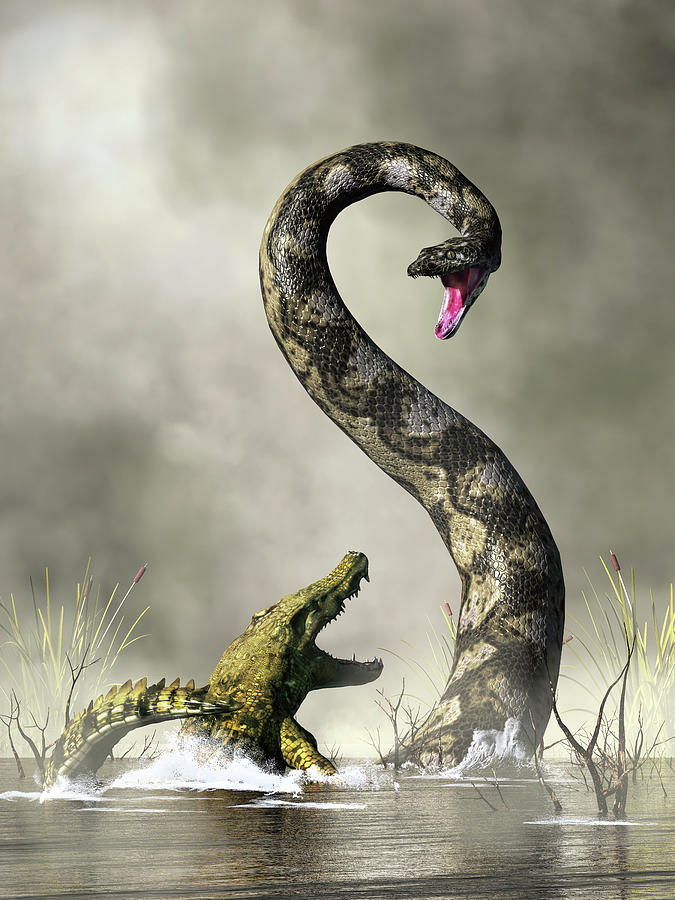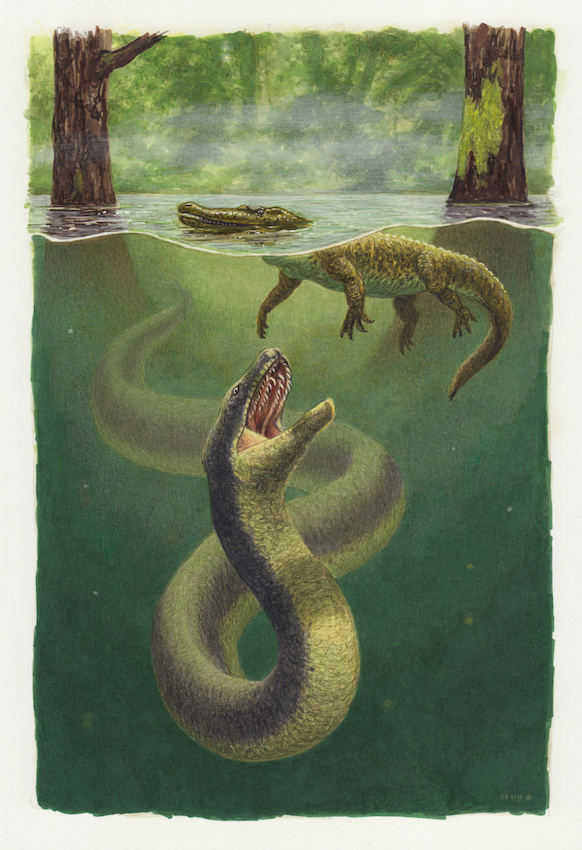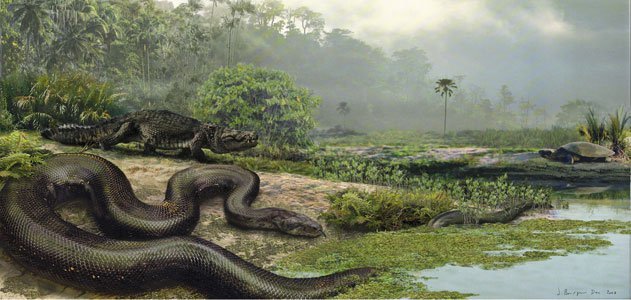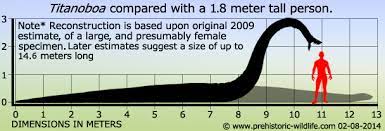 A little reading of Robert E. Howard will give you the idea he did not like snakes. Giant snakes show up in three of the Conan stories and in one of the James Allison stories. That is not counting snakes of the supernatural type in “The Cobra in the Dream” and “The Dream Snake.”
A little reading of Robert E. Howard will give you the idea he did not like snakes. Giant snakes show up in three of the Conan stories and in one of the James Allison stories. That is not counting snakes of the supernatural type in “The Cobra in the Dream” and “The Dream Snake.”
Snakes evolved from burrowing or aquatic lizards. The oldest fossils of true snakes are from the Cretaceous period 112-94 million years ago. The K-T extinction event 66 million years wiped out the dinosaurs but snakes made it through along with other reptiles including turtles, crocodilians, and lizards. Snakes got big fast.
In the mid-Paleocene, 60 million years ago, the massive Titanoboa measuring up to 50 feet was found in South America. Global temperatures were far warmer than today with dense tropical and sub-tropical forests reaching into the polar regions. The high temperatures allowed for big reptiles.
Titanoboa was a member of the Boinae family that includes boas today. Estimated weight is 2,502 lbs (1,135 kg). What could the largest snake in history eat? Probably anything it wanted. Mammals were increasing in size in the Paleocene but probably the size of a sheep at most. It has been suggested Titanoboa ate crocodilians including the interestingly named Acheron crocodile.
That brings another question: what were these crocodilians eating? There were some massive turtles that had shells that measured 5 ft, 8 inches. It is now thought Titanoboa probably ate fish, especially lungfish.
A second giant prehistoric snake is Gigantophis from the Late Eocene. Fossils have been found in Algeria and Pakistan. It measured around 33 ft and may have weighed half a ton. The giant snakes appear to have gone into decline when the average Earth temperature declined at the Eocene-Oligocene transition.
Giant snakes still lurk in the fiction of Robert E. Howard. Menacing reptiles are found in swampy jungles. That is where chaos reigns.

The first appearance of a giant snake is in “The Scarlet Citadel” (Weird Tales, January 1933).
“Beyond the ring of dim light he saw a vague and colossal form, awful even in its indistinctness. It reared upright, swaying slightly, and yellow eyes burned icily on him from the shadows. Slowly a huge, hideous, wedge-shaped head took form before his dilated eyes, and from the darkness oozed, in flowing scaly coils, the ultimate horror of reptilian development.
It was a snake that dwarfed all Conan’s previous ideas of snakes. Eighty feet it stretched from its pointed tail to its triangular head, which was bigger than that of a horse. In the dim light its scales glistened coldly, white as hoar-frost.”
Conan meets another snake in “The Devil in Iron:
“CONAN cleared the space between him and the throne with a desperate bound, his scimitar swinging with all his power. And with such blinding speed did the serpent move that it whipped about and met him in full midair, lapping his limbs and body with half a dozen coils. His half-checked stroke fell futilely as he crashed down on the dais, gashing the scaly trunk but not severing it.”
Conan did not tangle with the saber-tooth tiger but took out another big snake in “Beyond the Black River:”
“The horror of his fate paralyzed him. That was the reptile that the ancients called Ghost Snake, the pale, abominable terror that of old glided into huts by night to devour whole families. . . As in a dream Balthus saw a short throwing-spear transfixing the mighty neck, just below the gaping jaws; the shaft protruded from one side, the steel head from the other.”

The Stygians keep snakes in their temples to come out and feast on hapless victims. From “Hour of the Dragon:”
“Then about the dark corner of the building he was approaching poked a hideous, wedge-shaped head, and after it flowed coil after coil of rippling, darkly glistening trunk.”
Lastly, Niord kills the huge Satha in “The Valley of the Worm” in order to get snake venom to kill the “worm.”
An interesting post-script. In 1959, Col. Remy van Lierde of the Belgian Air Force claimed to have seen a 50 foot snake in Katanga province of the Belgian Congo from his helicopter. He described it as having dark green and brown scales. There is a picture of the snake. Arthur C. Clarke considered van Lierde a credible witness.

Please give us your valuable comment